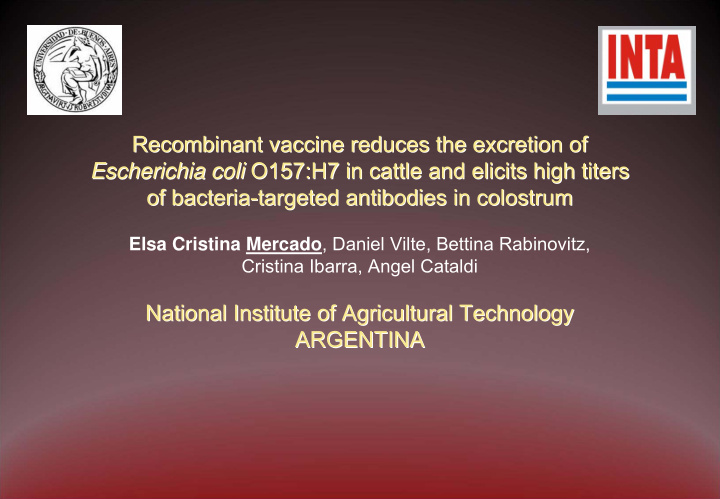



Recombinant vaccine reduces the excretion of Recombinant vaccine reduces the excretion of Escherichia coli O157:H7 in cattle and elicits high titers O157:H7 in cattle and elicits high titers Escherichia coli of bacteria- -targeted antibodies in colostrum targeted antibodies in colostrum of bacteria Elsa Cristina Mercado , Daniel Vilte, Bettina Rabinovitz, Cristina Ibarra, Angel Cataldi National Institute of Agricultural Technology National Institute of Agricultural Technology ARGENTINA ARGENTINA
� Enterohemorrhagic Escherichia coli O157: H7 was the most prevalent EHEC serotype recovered from patients with hemolytic uremic syndrome (HUS) in the world. � Argentina is a country with a very high incidence of HUS in children, 14 cases per 100 000 children younger than 5 years old (2006). � Pre-slaughter vaccination of cattle, the main reservoir of EHEC O157: H7, could be a logical strategy to reduce the incidence of infection in humans. � Vaccination of pregnant cows could be also a tool to obtain antibodies-targeted dairy products. � This study evaluated a vaccine based in a fragment of Intimin and EspB, two key colonization factors of E. coli O157: H7.
Enterohemorrhagic Escherichia coli O157:H7 Shiga toxins and Attaching and Effacing lesion LEE (Locus E nterocyte Effacement) Type Three Secretion System (TTSS)
Previous works � Immunoglobulin enriched cow colostrum protects mice against E. coli O157:H7 infections by prevention of bacterial attachment, colonization and growth in the intestinal tract in mice (Funatogawa et al ., Microbial Immunol 2002; 46: 761) � Neutralizing activity of bovine colostral antibody against verotoxin derived from enterohemorrhagic E. coli O157:H7 in mice (Kuribayashi et al ., J Infect Chemother 2006; 12:251) � Bovine colostral antibody against verotoxin 2 derived from E. coli O157:H7: resistance to proteases and effects in beagle dogs (Kuribayashi et al ., Comp Med 2009; 59:163)
Presence of specific-antibodies against Intimin and Esp proteins in colostrum from cows non experimentally immunized Antigenicity of Intimin and Esp proteins in mice intranasally immunized
1 ° Vaccine Trial 1 ° Vaccine Trial REDUCED EXCRETION OF Escherichia coli Escherichia coli O157: H7 IN CATTLE O157: H7 IN CATTLE REDUCED EXCRETION OF AFTER VACCINATION WITH INTIMIN AND EspB EspB PROTEINS PROTEINS AFTER VACCINATION WITH INTIMIN AND Holstein calves 6-8 months old Animals Animals Negatives for E. coli O157:H7 Groups: Vaccinated and Control Recombinant proteins EspB and Intimin Vaccine Vaccine + adjuvant Control: PBS Containment Facilities BS II Containment Facilities
� Vaccine: two doses � Challenge 10 9 CFU E. coli O157:H7 438/99 Nal R � Samples. serum, saliva, feces, rectoanal mucosal swabs
RESULTS RESULTS � A significant reduction in total bacterial shedding of E. coli O157:H7 excreting animals were observed in the vaccinated group compared to the control group over the sampling period � High titers of Intimin and EspB –specific IgG antibodies were observed after the first immunization in the vaccinated calves, compared to control animals ( P ≤ 0.001, t ‐ test). � A significant IgA response against both proteins was observed in saliva after the first immunization ( P ≤ 0.05 , t ‐ test). � An IgG specific response against both proteins was also observed in saliva 21 days after the first immunization. ( P ≤ 0.05, t ‐ test).
2°Vaccine Trial 2°Vaccine Trial SYSTEMIC IMMUNIZATION OF COWS WITH EspA, EspB, INTIMIN and Stx2 SYSTEMIC IMMUNIZATION OF COWS WITH EspA, EspB, INTIMIN and Stx2 PROTEINS FROM Escherichia coli Escherichia coli O157:H7 INDUCES SPECIFIC O157:H7 INDUCES SPECIFIC PROTEINS FROM COLOSTRAL ANTIBODIES THAT ARE EFFICIENTLY TRANSFERRED TO COLOSTRAL ANTIBODIES THAT ARE EFFICIENTLY TRANSFERRED TO NEWBORN CALVES. NEWBORN CALVES. Holstein pregnant cows confirmed to be negative for EHEC O157:H7 infection Animals Animals Groups: Vaccinated and Control Recombinant proteins EspA, EspB and Intimin and Vaccine Vaccine inactivated Shiga toxin type 2 + adjuvant Control: PBS + adjuvant Containment Facilities Containment Facilities Dairy herd at Rafaela Experimental Station ‐ INTA
� Vaccine: three doses � Samples cows: serum, colostrum, milk � Samples calves: serum, feces
RESULTS RESULTS � Cows mounted high colostrum IgG titers to Intimin, EspA and EspB � Cows and colostrum ‐ fed calves also exhibited serum IgG antibodies against EspA, EspB and Intimin � Western blotting confirmed the specificity of the responses measured by ELISA � Colostrum from Stx2 ‐ vaccinated cows exhibited high Stx2 ‐ neutralizing antibodies titers compared with the control group
Final Conclusions Final Conclusions � Im Immunization with recombinants Intimin and EspB proteins seems to � be a feasible strategy to reduce EHEC O157:H7 fecal shedding in cattle. � Hyperimmune colostrum from cows immunized with Hyperimmune colostrum from cows immunized with Intimin and EspB � proteins is a source of antibodies against EHEC O157:H7 which source of antibodies against EHEC O157:H7 which could block the colonization and toxic activity of that bacterium in m in could block the colonization and toxic activity of that bacteriu the human intestine. the human intestine. � Dairy products with EHEC O157:H7 Dairy products with EHEC O157:H7- -targeted antibodies could be a targeted antibodies could be a � useful tool to decrease the risk of the progression of diarrhea to to useful tool to decrease the risk of the progression of diarrhea HUS on children. HUS on children.
This work was supported by grants PICTO 2002 12923 and PICT 2005 32687 of the National Agency for the Promotion of Science and Technology and INTA AESA 2582
National Institute of Agricultural Technology National Center for Veterinary and Agronomic Research Thank you very much for your attention!
Recommend
More recommend